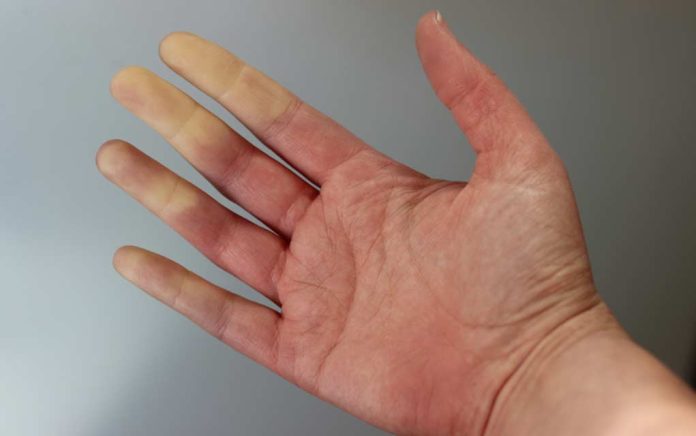
(HealthyResearch.com) – Red, white and blue extremities might look like a show of patriotism, but it’s really a sneaky and potentially dangerous medical problem. Raynaud’s disease is a condition that affects the blood vessels and restricts circulation to the extremities. It can strike for multiple reasons, but there are steps you can take to minimize the risks of an attack. We have the details of this painful and potentially devastating condition.
What Is Raynaud’s?
Raynaud’s is a rare disorder that causes temporary narrowing of the blood vessels, or vasospasm. This can affect the circulation to the extremities. It most often affects the fingers, but it can also strike the toes, ears, nose, sometimes even the nipples and lips. Most people experience only mild symptoms, with no lasting damage between episodes, but severe cases can lead to skin sores and tissue death.
There are two classifications of Raynaud’s. Primary Raynaud’s occurs for unknown reasons, but most cases are mild. Secondary Raynaud’s syndrome occurs as the result of another condition, usually an autoimmune or connective tissue disease. You may also see it alongside thyroid disorders, pulmonary hypertension, and certain blood disorders.
Knowing the Symptoms
Raynaud’s causes numbness and discoloration in the affected areas, usually turning them white in response to cold temperatures when the veins narrow and blood flow is extremely restricted, blue in response to oxygen deprivation and lack of blood flow, and red upon introduction to warmer temperatures. This can be painful and may be followed by swelling. Some people experience attacks in response to emotional stress. The TV show “Today” reported that about 5% of the population experiences Raynaud’s symptoms.
Reducing Your Risks
Women under 30 are most likely to develop Raynaud’s, but risks are also higher in people who do repetitive movements or use vibrating tools. This includes people who play piano, type, or work with power tools. Nicotine, beta-blockers, birth control pills, and certain medications for cancer, allergies, and migraines can also lead to symptoms.
You can reduce your risks of having an attack by avoiding the cold or bundling up when you can’t avoid it and avoiding trauma to the extremities. You may find it helpful to take a blood pressure medication during the winter months. If you’re a smoker, consider quitting.
Raynaud’s can be a painful and serious condition, but you can keep it controlled. You may even be able to reduce your symptoms with a few lifestyle changes. Not sure whether you have it? Talk to your doctor for an assessment and treatment options. The Raynaud’s Association offers an interactive quiz that may also point you in the right direction.
~Here’s to Your Health & Safety!
Copyright 2021, HealthyResearch.com
















